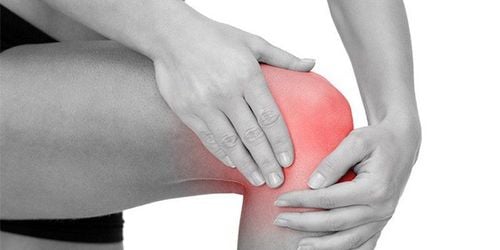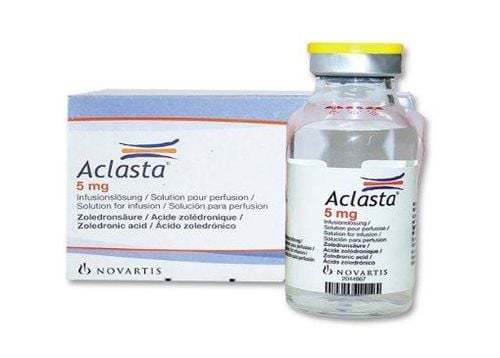This is an automatically translated article.
With the main ingredient is Risedronate sodium, Dronagi has the effect of treating and preventing osteoporosis in both men and women. Adhering to the indications, the dose of Dronagi will help patients improve the effectiveness of treatment and avoid unwanted side effects.
1. What disease does Dronagi treat?
Dronagi belongs to the group of drugs for the treatment of gout and osteoarthritis, with the main ingredient being Risedronate sodium (in the form of Risedronate sodium hemi-pentahydrate) content 35mg. Risedronate belongs to the group of non-steroidal drugs, which have effects on bone, reduce the likelihood of fractures, prevent bone resorption (in combination with hydroxyapatite) and inhibit osteoclasts at the cellular level.Dronagi is formulated as a film-coated tablet and is indicated for use in the following cases:
Treatment of osteoporosis in both men and women. Prevention of osteoporosis and osteoporotic fractures in postmenopausal women.
2. Usage and dosage of Dronagi
Dronagi is taken orally. The patient should swallow the tablet whole with water, do not chew or break it. Should take the medicine before eating, on an empty stomach, specifically at least 30 minutes before breakfast, at least 2 hours after eating or at least 30 minutes before going to bed. After taking the medicine, do not lie down for 30 minutes. Do not take Dronagi with calcium, vitamin D or Risedronate. Instead, add calcium and vitamin D in your daily diet, for example by drinking more milk or dairy products. The recommended adult dose of Dronagi is one 35 mg tablet per week. In order not to forget the medicine, it is recommended to take it fixed on 1 day of the week. If you forget, the patient needs to take it as soon as he remembers and the next week, he needs to take it on a fixed date. Note, within 1 day do not take 2 tablets of 35mg. Overdosage of Dronagi can cause a serious decrease in serum calcium and phosphorus. In this case, the patient should be given milk or antacids containing calcium, magnesium, and aluminum to reduce the absorption of the drug. If there is severe hypocalcemia due to Dronagi overdose, the patient should be taken to a medical facility immediately for gastric lavage to remove the unabsorbed drug or intravenous calcium injection to restore ionized calcium and relieve symptoms caused by hypocalcaemia.
3. Side effects of the drug Dronagi
Dronagi may cause some unwanted side effects with the frequency of occurrence as follows:
Common: Abdominal pain, nausea, vomiting, indigestion, constipation, diarrhea, headache and musculoskeletal pain joint. Uncommon: Dysphagia, esophagitis, gastritis - duodenitis, decreased calcium and phosphate in the blood, iritis. Rare: Glossitis, esophageal stricture, pruritic rash, angioedema, liver enzyme disorders and leukopenia. Most of the effects of Dronagi are mild to moderate, and patients do not need to stop taking the drug to treat side effects. However, if you see any unusual symptoms after taking the drug, you should immediately report it to your doctor and soon go to a medical facility for a health check.
4. Some notes when using Dronagi
Do not use Dronagi in people with hypersensitivity to the ingredients of the drug, people with hypocalcemia, severe renal failure (with creatinine clearance less than 30ml/min), people with abnormal esophagus (such as esophageal stricture, oesophagus), people who have lost the ability to sit or stand for at least 30 minutes, pregnant or lactating women, adolescents, and children. Taking Dronagi with food or drinks or preparations containing calcium, magnesium, iron, or aluminum may interfere with the absorption of the drug. So do not use at the same time and should take the medicine before eating or drinking at least 30 minutes. People with a history of esophageal disorders (esophageal stricture, esophageal stricture) or digestive problems (Barrett's esophagus), people with imbalance should be careful when taking Dronagi because the drug can cause digestive upset. with symptoms such as dysphagia, esophagitis and peptic ulcer disease. While taking the drug, the patient should follow the doctor's instructions to reduce the risk of Dronagi side effects. Before taking the drug, patients need to treat hypocalcaemia, radical bone-mineral metabolism disorders (diseases such as vitamin D deficiency, parathyroid dysfunction). People with Paget's disease, if supplemented with calcium and vitamin D, can significantly increase bone turnover. Before using Dronagi for the treatment and prevention of osteoporosis, sex steroid hormone status (both men and women) should be evaluated to consider alternative treatment options. Before treatment with Dronagi, the patient should have a dental examination and should avoid performing invasive dental procedures such as tooth extraction, which may increase the risk of osteonecrosis of the jaw. This is especially so in patients with risk factors such as poor oral hygiene, taking corticosteroids, cancer, chemotherapy or radiation therapy. In the event that a dental procedure is necessary, the patient should stop taking Dronagi to reduce the risk of osteonecrosis of the jaw. However, it is important to talk to your doctor to assess the risks and benefits of stopping the drug. During the use of Dronagi, patients should inform their doctor if they experience hip, groin, or thigh pain because the drug may increase the risk of atypical femoral fractures, especially in patients treated for osteoporosis. for a long time. Stop taking Dronagi and tell your doctor if you have symptoms of a fracture in your limbs. Women who are pregnant or breastfeeding should not take Dronagi, unless absolutely necessary and have been evaluated, weighing the risks and benefits to the fetus and newborn. Dronagi may be used concurrently with an estrogen supplement after careful consideration. In summary, the use of Dronagi drug is to reduce the possibility of bone fractures, prevent bone resorption and inhibit osteoclasts. With this use, Dronagi is used to treat and prevent osteoporosis as well as fracture complications caused by osteoporosis.













